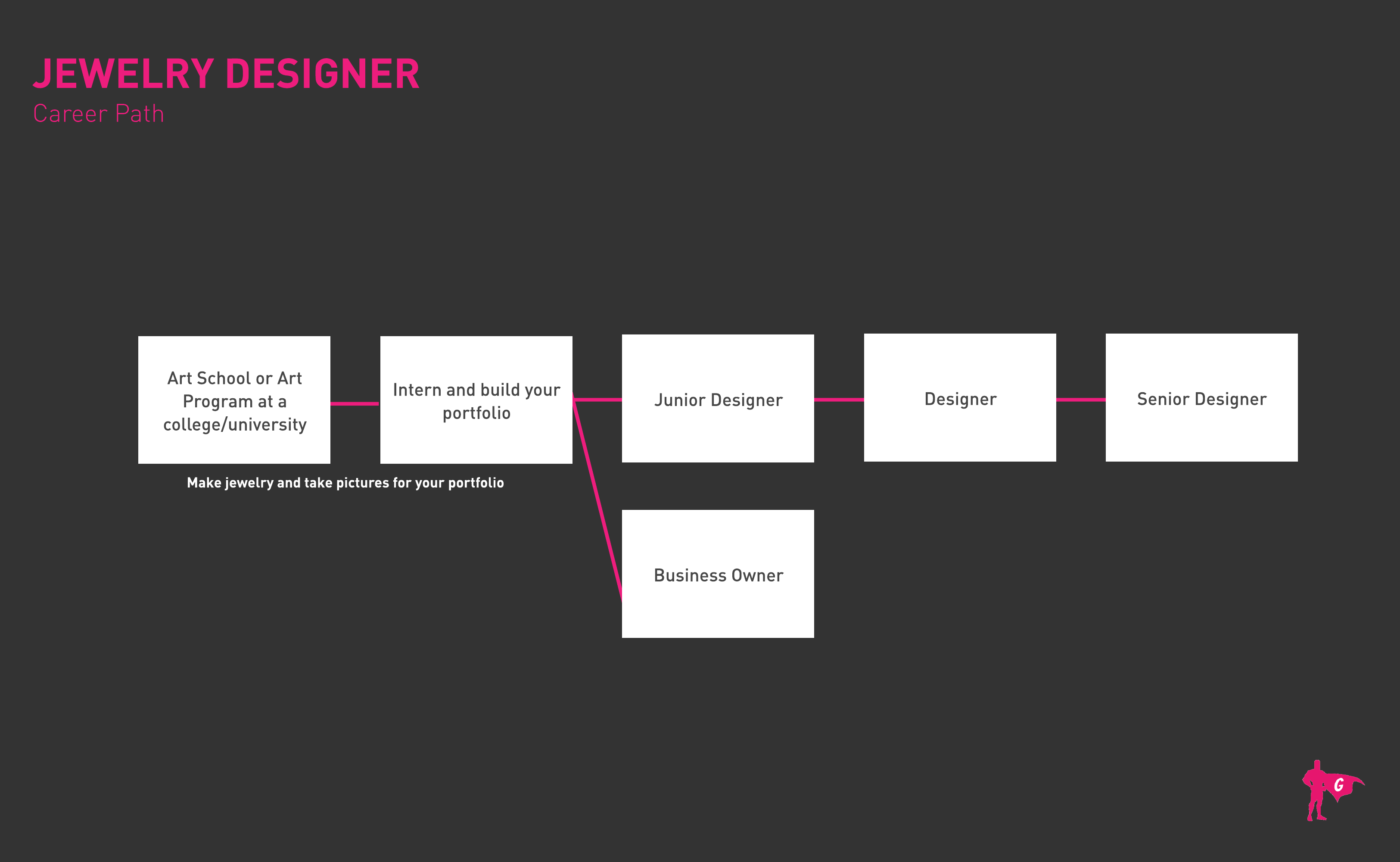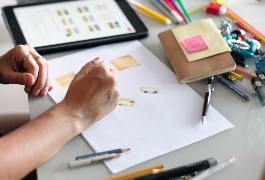스포트라이트
아티스트, 벤치 보석상, 캐스터, 귀걸이 제작자, 보석학자, 금세공인, 보석상공인, 플래티넘 세공인, 복원 은세공인, 은세공
A jewelry designer is an artist that uses jewelry design as their medium. They may work with non-precious materials to produce ‘fashion’ jewelry, or with expensive ‘fine’ jewelry materials like platinum and diamonds. Some jewelry designers simply create the idea for jewelry, while others work with the materials and produce the jewelry.
디자인 부분은 예술적 스타일과 개념에 중점을 두며 컴퓨터 그래픽 및 모델 또는 손으로 그린 그림 또는 금형의 도움을받을 수 있습니다. 일부 디자이너는 자신을 보석상, 보석학자 또는 '대장장이'라고 생각하기도 합니다.
- 예술적으로 자신을 표현할 수 있음
- 다른 직업과 비교할 때 덜 공식적이거나 구조화된 환경에서 일할 수 있음
- 현장 학습과 지식과 기술을 확장하는 능력은 제한되지 않습니다.
- 아름다운 예술 창조
- 고급 재료 및 패션 작업
- 자영업/기업가 정신의 높은 가능성
보석 디자이너는 이름에서 알 수 있듯이 보석을 디자인합니다. 이것은 독립 디자이너로서 소규모일 수도 있고 주요 패션 및 보석 회사와 대규모로 협력할 수도 있습니다. 보석 디자이너의 예술적 측면은 분명히 매력 중 하나이지만 기술적 측면도 작용합니다.
디자이너는 자신이 디자인한 아이템이 쉽게 깨지지 않고 착용할 수 있는지 또는 재료가 서로 잘 작동하는지 확인해야 할 수 있습니다. 컴퓨터 디자인, 왁스 및 수지 금형, 야금은 아이디어가 개념에서 창조로 넘어갈 때 디자이너가 사용할 수 있는 몇 가지 기술적 측면입니다.
일반적인 의무
- 상상력, 창의력 및 예술적 능력을 사용하여 보석 조각 개념화 시작
- 손으로 또는 컴퓨터 모델링 소프트웨어를 사용하여 렌더링 수행
- 점토, 왁스, 수지 및 기타 재료를 사용하여 금형, 프리캐스트 또는 모델 생성
- 보석, 금속 및 기타 재료의 가치 평가
- 납땜과 같은 금속 가공 또는 야금 작업 수행
- 보석류의 유용성 보장
- 맞춤 주문 디자인
- 깨끗한 보석
- 수리 보석
- 가죽 및 직물과 같은 재료로 작업
- Cut and polish gemstones
추가 책임
- 조각에 대한 상표권 침해 확인
- Manage a business (if self-employed). This may include setting up websites, bookkeeping, inventory control, shipping, etc.
- 현재 패션 및 보석 트렌드 모니터링
소프트 스킬
- 세부 사항에 대한 관심 – 보석 디자인은 종종 미니어처로 수행되며 세부 사항에 대한 예리한 주의가 필요합니다.
- 창의성 – 이것은 모든 예술적 또는 디자인 추구의 전체 기초를 형성합니다.
- 커뮤니케이션 – 특히 맞춤형 디자인에서 고객의 요구를 완전히 이해하는 능력.
- 고객 서비스.
- 시간 관리 – 생산 일정이 충족되도록 합니다.
- 연구 – 현재 디자인 트렌드와 기술 발전을 따라갈 수 있습니다.
- 과학 – 보석 디자인은 특히 보석 및 기타 재료에 대한 야금 및 지식에 대한 많은 과학 지식을 통합합니다.
- 훌륭한 수동 손재주.
기술 능력
- Some jewelry designers may be employed by jewelers, in either a small business setting or within large, well known jewelry and fashion design brands. Others are self-employed entrepreneurs who work from home, attend trade shows and craft fairs, and utilize online marketplaces.
이것은 주로 창의적인 직업이고 예술적 소명으로 생각하기 때문에 추구하는 직업이지만 여전히 몇 가지 단점이 있습니다. 시장은 항상 혁신적인 디자인을 위해 열려 있지만 대형 보석상과 협력하지 않는 한 디자인을 제작하기가 어려울 수 있습니다. 직접 디자인하고 만드는 경우 값 비싼 장비와 소프트웨어를 구입해야 할 수도 있습니다. 안정적인 고용과 임금이 부족할 수도 있습니다.
고용은 풀 타임 또는 파트 타임이 될 수 있으며 화학 연기, 금속 프레스, 레이저 등이 사용될 수있는 환경에있을 수 있습니다.
보석 디자이너로서의 경력에 대한 예측은 변화의 방식으로 많이 나타나지 않지만 저렴한 소프트웨어 및 장비의 접근성은 긍정적 인 기울기를 보여줍니다. 인터넷과 많은 틈새 플랫폼의 도달 범위와 결합하여 디자이너는 자기 관리를위한 많은 기회를 가지고 있습니다.
어렸을 때 보석 디자이너는 종종 예술적으로 기울어졌습니다. 이것은 그림, 그림 그리기 또는 조각을 의미할 수 있습니다. 패션쇼를 열거나, 부모의 보석을 착용하거나, 패션과 관련된 미디어에 집중하는 것도 매우 일반적인 관심사입니다. 많은 앱과 소프트웨어를 사용할 수 있기 때문에 젊은 디자이너는 이미 CAD 또는 디자인 프로그램에서도 만지작거렸을 수 있습니다.
보석 디자이너가 되기 위해 정규 교육은 필요하지 않지만 고등학교 졸업장 또는 이와 동등한 자격을 취득하는 것은 항상 좋은 생각입니다. 많은 디자이너가 취미로 시작하여 결국 디자인이나 제품 판매로 이동합니다.
패션 또는 보석 업계에서 일하는 것이 목표라면 고등 교육을 추구하는 것이 여전히 좋은 생각일 것입니다. 예술, 패션, 디자인 및 보석학은 일반적인 교육 활동입니다. CAD/CAM 소프트웨어, 3D 프린터 등을 사용하는 기술 과정 및 인증도 필요할 수 있습니다.
인턴십과 현장 교육은 보석 디자인을 시작하는 또 다른 훌륭한 방법입니다. 이것은 직업 학교 프로그램, 회사 주도 교육, 견습 및 독학을 통해 수행할 수 있습니다.
예술과 디자인에 대한 강한 초점은 아마도이 경력을 추구 할 때 찾아야 할 가장 큰 것입니다. 하위 전문 분야에는 보석 또는 금속에 대한 집중 연구가 포함될 수 있습니다. 졸업 후 또는 견습 또는 인턴 직책이 제공되는 과정을 이수한 후 실제 업무 경험을 활용하는 것도 도움이 됩니다.
관련 교육 경로가 있는 일부 기관은 다음과 같습니다.
- 높은 GPA 유지
- 미술 수업 듣기
- 집에서 또는 평생 교육 과정에서 CAD 소프트웨어 배우기
- 패션 트렌드에 익숙해지기
- 견습 또는 인턴십 찾기
- 잠재적 인 학교 또는 고용주를 보여주기 위해 작업 포트폴리오를 만듭니다.
- 미술에 입학하려는 사람들을위한 장학금을 찾으십시오.
- 대학 준비 과정 찾기 및 수강

- 독립 디자이너로 나아가기로 결정하셨다면 축하드립니다! 방금 고용하셨습니다! 고객을 확보하려면 마케팅을 하고 다양한 사람들과 비즈니스에 재능을 보여줘야 합니다.
- 포트폴리오 또는 작업 본문 발표
- 당신이 적용하고 있는 디자인의 틈새 시장을 이해하고 당신의 창의적인 비전이 그들이 찾고 있는 것과 일치하는지 확인하십시오.
- 업계 지식과 개인 디자인 아이디어를 준비하십시오.
- 면접에 적합한 복장
- 찾고있는 경력을 칭찬하는 이력서를 작성하십시오.
- 최고 수준의 작업 품질 유지
- 미술 준회원과 같은 관련 분야의 지속적인 교육
- 업계의 조직 및 위원회 위원이 되십시오.
- 최신 보석 및 디자인 혁신에 대한 최신 정보를 얻으십시오.
웹사이트
책
- 역사를 만든 보석: 101개의 돌, 신화, 전설, 스텔린 볼란데스
- 보석: 결정적인 비주얼 가이드, 아자 라덴
- 현대 보석 디자인 마스터하기: 영감, 프로세스 및 목소리 찾기, Loretta Lam
보석 디자인이 카드에 없다면 보석 디자인이하는 창의적이고 예술적인 프로세스를 여전히 활용하는 많은 작업이 있습니다. 고려해야 할 다른 옵션은 다음과 같습니다.
뉴스 피드

주요 채용 정보

온라인 과정 및 도구








